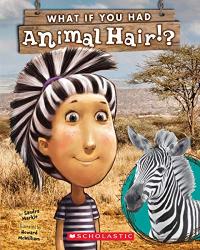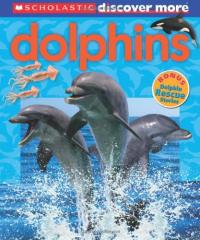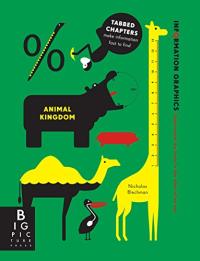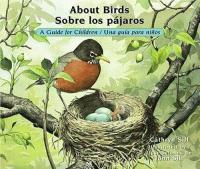
Bird basics — from characteristics to colors — are briefly introduced in an attractive, accessible package. In addition to a table of contents, glossary and index, this series provides additional material on birding (bird-watching) via an online, downloadable book.
Discover More: Birds

Each dramatic photograph of an animal (such as a pink flamingo) on a white background is accompanied by one word: its color. In Creature Numbers (opens in a new window), Animals from 1 to 10 bounce, swim, and pose on the equally open pages of a companion book for a fine, fun introduction to basic concepts.
Creature Colors

This look at vertebrates glimpses mammals, fish, birds, reptiles and amphibians though rhyming couplets and attractive, textured woodcuts. A brief outline of characteristics and examples in each category and further resources are also included.
Animal School: What Class Are You?

Caldecott medalist Mordicai Gerstein captures the majestic redwoods of Yosemite in this little-known but important story from our nation’s history. In 1903, President Theodore Roosevelt joined naturalist John Muir on a trip to Yosemite. Camping by themselves in the uncharted woods, the two men saw sights and held discussions that would ultimately lead to the establishment of our National Parks. [Good Reads]
The Camping Trip That Changed America

Animals and people both have hair. Photographs of animals and droll illustrations of kids with that hair on opposing pages provide a light, humorous, and surprisingly informative look at different animals — and of course, hair.
What If You Had Animal Hair?

“Our world is made of land and water.” The land is called continents; the water oceans. Select animals that live on each continent are presented on sturdy, textured pages that will hold up to multiple readings and handling by young children while providing a visually appealing introduction to maps and animals.
Montessori: Map Work

Most elephant seals live in the ocean but one prefers the Avon River in Christchurch, New Zealand. Though the townspeople try to relocate Elizabeth, the huge seal finds her way back three times to the delight of many, especially a boy named Michael. Based on a true story, this well-told fictionalized account is expressively illustrated.
Elizabeth, Queen of the Seas

Splendid photographs are used along with a crisp, easier to read narrative to introduce dolphins, water-dwelling mammals. A glossary, index and access to additional online material complete this appealing and edifying title.
Dolphins

Richly hued, lush, realistic illustrations answer the question of what a child might see during the day: a sun-dappled bird, butterfly, or beaver perhaps. At night, there could be a bat or a firefly in moonlight, and a teddy bear as she snuggles into bed.
Daytime Nighttime

An eclectic collection of factoids about animals is presented in an eye-catching, brightly colored format that uses graphic art or “infographics.” The result is a fetching book sure to engage sophisticated readers as they dip in and out.
Information Graphics: Animal Kingdom

Handsome, realistic illustrations accompanied by straightforward information about North American birds encourage children to observe birds closely. Additional information about characteristics and bird identification concludes this attractive and informative book.
About Birds / Sobre los parjaros

Geo along with Dr. Brain and a couple of friends explore the digestive system from within in their nano-ship. The last chapter sets up the team’s next adventure. First published in South Korea and translated into English, the comic book format provides adventure and information.
Survive! Inside the Human Body Volume 1: The Digestive System

Guess whose silhouette? Find out with a lift of a flap. Examine a close-up, lift the tab and up pops a small ocean-dwelling creature. Put pages together to see an entire fish. The large format and sturdy pages with meticulous illustrations engage, surprise, and hold lots of information for readers.
The Open Ocean

Clear photographs in a colorful format combine with brief information to provide an introduction to ants. A photo-glossary, index and an age-appropriate website for more information extends the use and appeal of this book (and the series).
Ants

A young Ashanti boy invites readers to visit his West African village, famous for fine kente cloth, and to share his “magic” — a masterful imagination. Kofi is an engaging scamp whose vivid “daydreams” that transport him to other places will speak to children everywhere and present them with a clear vision of his beloved West African world. [School Library Journal]
Kofi and His Magic

“Hello, Stranger-Friend” begins Maya Angelou’s story about Thandi, a South African Ndebele girl, her mischievous brother, her beloved chicken, and the astonishing mural art produced by the women of her tribe. With never-before-seen photographs of the very private Ndebele women and their paintings, this unique book shows the passing of traditions from parent to child and introduces young readers to a new culture.
My Painted House, My Friendly Chicken, and Me

As seasons change, Alice and her friend, Zack, notice changes in the length of the day. Together with Alice’s little brother, the children examine the changing seasons as they observe birds, animal tracks, and more. Two articulate chickens named Maisy and Daisy add a bit of whimsical humor as well as scientific detail in this winning and enlightening book.
Secrets of the Seasons

“I am a plant eater,” announces a boy with a wide grin eating munching on a slice of watermelon and surrounded by a harvest of fruits and vegetables. He then introduces where, how, and the different parts of what he (and we) eat. Cheery, informative illustrations are clearly labeled and correspond to the straightforward, engaging text.
Plants Feed Me

Birds craft surprisingly unique nests. Brief verses introduce different birds and how their nest is made complemented by equally engaging but concise factual information in a different typeface. Memorable illustrations are realistic, made of cut paper collages placed on uncluttered pages.
Mama Built a Little Nest

Water is essential for all life on earth. In the author’s signature style, the water cycle, clouds, and more are introduced. Straightforward language and characteristic illustrations include maps, cautions, and additional tidbits of information about rain and related topics.
It’s Raining

The mayor of Food Town introduces each of the five groups: grains, vegetables, fruit, protein, and dairy. Each personified group parades through town with its relatives. Humorous illustrations of foods with personality, all labeled, are used with an understated text to present palatable nutrition information. A bit more easily digestible information ends the book.
The Food Parade: Healthy Eating with Nutritious Food Groups

Fog is the only type of cloud that is close enough to feel; all other clouds can only be seen. Folk art and crisp text brings different types of clouds into focus for budding scientists. Cloud facts and directions for making a cloud in a jar conclude this informative and engaging introduction to clouds, weather, and observation.
Clouds

While children cavort through a sprinkler on a suburban lawn, animals thrive or survive in other habitats (desert, field, wetland, and seaside). The same sun has a different effect in different places on all living creatures presented in a clear text and handsome, realistic, detailed illustrations.
Beneath the Sun

They met in the middle, the workers who built the railway across the United States. The narration speaks directly to readers which follows two unnamed children journey to California. Combined with richly detailed illustration, this dramatic, informative journey is the winner of the 2014 Caldecott Medal. (2014 Caldecott Medal Winner)
